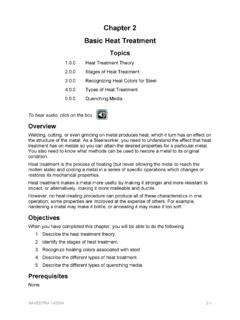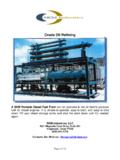Transcription of Oven Safety 101 - Understanding NFPA 86
1 ovens . Oven Safety 101: Understanding nfpa 86. Whether you have a direct gas- fired or an electrically heated oven, Understanding and following the nfpa 86 standard can minimize the risk of a catastrophic event at your plant. By GUANCI III, PRECISION QUINCY CORP. What are the most important components of oven selection? Airflow and its subsequent interaction with product in a given loading pattern? Sufficient thermal input as it relates to getting a given load to temperature? Acquiring and recording data for one's quality control program? Certainly, this list could go on for pages, but the answer will always be no. Are they important? Certainly. In fact, there are many questions critical to a successful application and a positive outcome.
2 But, those questions do not address the structure or framing in which ovens must be manufactured and applied. Adhering to those rules . outlined in the National Fire Protection Association's Bulletin 86 (commonly known as nfpa 86) is the single most important thing an oven builder, buyer and operator can do. nfpa 86's most recent revision was published in 1995. With new editions released every four or five years, it is a living document that has evolved with the times. Oven users may be confused when reading nfpa 86 because the listing for oven says simply, see furnace. Processors should not be misled. Although the text says furnace, oven users should not conclude that the section does not apply to them. Because nfpa sometimes interchanges oven and furnace, processors should always read further get into the details to be sure they are not overlooking important information.
3 Currently, there are two classifications pertaining to ovens : Class A and Class B. I'll start with some working definitions. It is important to discuss Class B ovens first they are more basic and simpler. Class A ovens include additional features not found on their Class B. counterparts. Class B ovens are those units meant solely for clean processes ..wherein there are no flammable volatiles or combustible materials being heated .. Conversely, Class A ovens are those units that can be utilized in processes with present solvents, volatile materials or other flammable or combustible contents. nfpa 86 cites several materials requiring the Class A rating, specifically including: Paints, powders, inks and adhesives from finishing processes such as dipped, coated, sprayed and impregnated materials The substrate material Wood, paper and plastic pallets, spacers or packaging materials Polymerization or other molecular arrangements.
4 Potentially flammable materials such as quench oils, waterborne finishes, cooling oil, or cooking oils that present a hazard are ventilated according to Class A standards. It is important to note that this list is not all-inclusive; rather, it serves as an overview of the types of materials or processes that are considered Class A in nature. Oven Safety : What's in it for You? The answer to that question is really another question: What's not in it for you? Reality: Everyone is impacted and everything is at stake, every single day reputation, bottom line, personnel confidence and morale, market position, profit, marketing, cost accounting, insurance rates and corporate survival. Disregarding oven Safety features or removing safeguards is inviting disaster through your company's front door.
5 Life becomes an even more dangerous and random game of chance like Russian roulette with only one empty chamber. For example, if just one Safety is jumpered say, an airflow switch the likelihood of an accident occurring has increased exponentially. If flammable fumes build up in the oven's work area, an explosion can take place. This would damage the oven, surely, but what of the other costs? Other equipment may become damaged or inoperable. The building itself may be damaged due to flame or the sheer force of the event. Most important, though, is the human element an employee, just someone trying to make an honest living may be hurt, incapacitated or killed. The economic, legal and moral repercussions of such an accident can be widespread, and the shock waves often are far reaching not only within the company, but in the individual lives with which your company is intertwined.
6 Safety is a big word a broad-brush concept that has been drummed into the collective industrial conscience for quite some time. However, the long-term battle to be safe is so often won and lost by small, seemingly insignificant practices (like bypassing a simple switch) that occur day-to-day. Oven Safety what's in it for you? A lot more than one might think. Electrically heated ovens With working definitions established, let's look at how they impact the way ovens are designed, equipped and applied. Class B - Electrically heated Class B ovens must be equipped with the following Safety equipment: Airflow Safety Switch - An airflow Safety switch should be integrated into the recirculation fan assembly, where it will shut down the unit should the fan cease operation.
7 This prevents the heat source from continuing to operate without recirculation air moving passed it. Manual Reset Excess Temperature Control - Commonly known in the industry as a hi-limit, this control should be set approximately 50 F (10 C) higher than the oven setpoint or maximum rated temperature. Should the unit produce too much heat; the hi-limit will trip and shut down the heaters once the excess temperature setting is reached. Backup Contactors - Backup contactors are required as a fail-safe. If the primary contactors become fouled or fused, the backup contactors will ensure that the heaters shut down if an over-temperature condition occurs. Class A - Electrically heated Class A ovens must have all of the Safety controls specified for Class B.
8 In addition, the following items are required: Powered Exhaust Fan - The oven must have an exhaust fan of sufficient size (measured in cubic feet per minute) to evacuate a sufficient quantity of fumes, smoke, etc. so that a buildup of hazardous materials in the oven's work area does not occur during processing. The amount (cfm) of required exhaust depends on many variables, including solvent/volatile material level, temperature, cycle time and cycle dynamics (ramp rate and soak duration). Extra Airflow Safety Switch - A second airflow Safety switch also is required. Should the exhaust fan fail for any reason, this second airflow switch acts as a fail-safe for the primary airflow switch and will shut down the heaters.
9 Purge Timer - A timed purge is required prior to heating. During this period, the recirculation and exhaust fans remove any flammable vapors and/or gases that may have entered the work area while the oven was idle. Extra Kilowatts (if required) - Electrically heated ovens equipped with Class A features may require additional kilowatts. Because the oven will be forcibly removing heat from the work area (via the required exhaust fan), more heaters may be needed to maintain process temperatures, depending on the heatup time and the maximum operating temperature. If this issue is not considered in the design stage, the oven may have a poor response time or be unable to reach the operating temperature necessary to run the load.
10 Extra Backup Contactors (if extra kilowatts are added) - If the oven is designed with extra kilowatts, additional backup contactors are required to provide adequate safeguards. Backup contactors will ensure that the heaters shut off should the primary contactors become fouled or fused. Internal Pressure Relief - The final extra that must be included in an electrically heated Class A oven is internal pressure relief. If a buildup of fumes leads to an explosion, this required feature will ensure that the event has an avenue of controlled release. Pressure relief typically is accomplished by incorporating pressure-relief doors or a caged pressure-relief panel. direct Gas- fired ovens All direct gas- fired ovens carry the Class A rating automatically because they introduce products of combustion into the oven work area.



